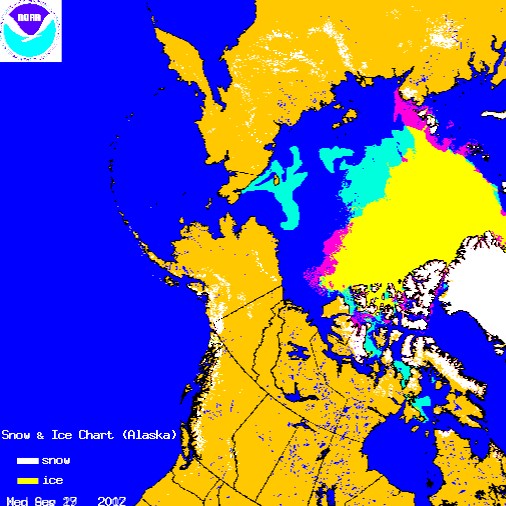Turquoise represents ice present in 2012 which wasn’t present at the 2007 minimum. Red shows the opposite. There is 22% more ice than there was at the 2007 minimum.
http://www.natice.noaa.gov/pub/ims/ims_gif/DATA/cursnow_alaska.gif
http://www.natice.noaa.gov/pub/ims/ims_gif/ARCHIVE/AK/2007/ims2007265_alaska.gif
Passive microwave measurements are missing vast areas of ice, because an early winter storm broke the ice up into chunks which the satellites are unable to detect. Alarmists are going hysterical, based on garbage data.



From WUWT:
http://wattsupwiththat.com/2012/08/27/sea-ice-news-volume-3-number-11-part-2-other-sources-show-no-record-low/#more-70029
August 19th: 40% more
August 25th: 36% more
August 27th: 28% more
August 28th: 22% more
… to be continued …
There are two different methods of measuring arctic ice coverage. That is a good thing, just as it is good that we have both land stations and satellites to measure air temperature.
Microwave indices see more water than ice, while NIC index sees more ice than water in mixed conditions. So they will each have distinct results and trends.
My only concern is that the news only reports the microwave results, and ignores the equally valid NIC index. As of today NIC shows artic ice extent tracking slightly above 2007. The data is available here:
http://www.natice.noaa.gov/products/ice_extent_graphs/arctic_daily_ice_extent.html
Select start year 2006 and month of August.
2 new bouys put out by the O-Bouy project. #7 & #8 are N of the Beaufort Sea in the Arctic Basin. Temps getting below zero. 0 to -4C. Last week they were as high 6C-8C. #6 NE of Greenland is running 0 to -2C.
http://obuoy.datatransport.org/monitor#overview/gpstracks
and again:
official temperature readings are taken in the shadow.
ice melts in direct sun light.
will you spot your error?
More of that “dramatic irony”. Heh.
no. just a fact. many here think, that the melting stops, the moment a single thermometer shows below 0°C.
thisa is false in about 1000 ways.
No-one here thinks that, sod. Look up “straw man” on your science box.
so what is the reason then, that people keep posting the “-0.3°C” number and similar rubbish? it has no meaning, unless you you don t understand how temperature is measured.
i have been pointing this out to steven and to other “sceptics” for a long time. Many of you folks do not understand this!
search for my comments.
http://wattsupwiththat.com/2010/07/02/agw-mathematics-30-5-0/
and JeffId
http://noconsensus.wordpress.com/2010/09/18/why-the-antarctic-is-not-melting-anytime-soon/
Hmm. Looks like someone is trying to divert the stream to a meaningless discussion about what someone may have said at some point far away and unconnected to this discussion. Let’s go back to your original statement:
Oh, goody. Now let’s go to the expert on insolation: sod! Will you sport your error?
I wonder what “insolation” means. Gosh! Words are really hard.
sod
there has been several times in recent human history when there has been less ice in the Arctic than there is right now. Will you spot your error?
Sod, you are a true goof. The next time it is 0C in your world, stick a brick of ice one cubic metre in your back yard in the direct sunlight. Not on your patio and not where the sunlight will reflect from your house. Watch how fast it melts. Then, leave it out overnight when the temperature dips to -5C and observe in the morning how much of the water that you saw the previous day has frozen. The point is that, if the daytime high is -0.3, the 4.5 metre ice is safe from melting this year and you can go back to your hibernation and crawl back into the daylight next summer.
And if you don’t live somewhere where the temperature gets to 0C, quit lecturing those of us who live where it is 0C or lower more days than when it is above 0C.
4.5 metre thick ice may melt slightly if it is sunny and 0C. But it will freeze again when the sun goes down in the sky. Very little will evaporate. The next morning, if it doesn’t snow, it will still be 4.5 metres of ice.
Up here in the world of ice and snow, we have contests where you park a car on a frozen lake and wait for the ice to melt and the car to go into the lake. The contest is that you guess the date when the car falls through the ice. As I drove by that very lake this spring on April 8th, a sunny, windy +7C day, the 27th day with a high above 0 in March and April this year. I won’t call it a melting day because I don’t know at what temperature things melt in your world. The car was still on top of some fairly thick ice. Some years it doesn’t drop until late May. At our fishing cabin on a lake that can only be accessed by air, we have canceled our trip some years because there is too much ice in early June to land safely.
Have a nice winter.